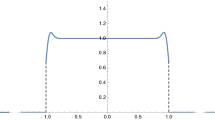Abstract
The Debye-Hückel theory describes rigorously the thermal equilibrium of classical Coulomb fluids in the high-temperature β→ 0 regime (β denotes the inverse temperature). It is generally believed that the Debye-Hückel theory and the systematic high-temperature expansion provide an adequate description also in the region of small strictly positive values of β > 0. This hypothesis is tested in the present paper on a two-dimensional Coulomb gas of pointlike +/− unit charges interacting via a logarithmic potential which is equivalent to an integrable sine-Gordon field model. In particular, we apply a form factor method to obtain the exact asymptotic large-distance behavior of particle correlation functions, considered in the charge and number density combinations. We first determine the general forms of the leading and subleading asymptotic terms at strictly positive β > 0 and then evaluate their high-temperature β→ 0 forms. In the case of the charge correlation function, the leading asymptotic term at a strictly positive β > 0 is also the leading one in the high-temperature β→ 0 regime. On the contrary, the β→ 0 behavior of the number density correlation function is accompanied by an interference between the first two asymptotic terms. Consequently, the large-distance behavior of this function exhibits a discontinuity when going from strictly positive values of β > 0 to the Debye-Hückel limit β→ 0. This is the crucial conclusion of the paper: the large-distance asymptotics and the high-temperature limit do not commute for the density correlation function of the two-dimensional Coulomb gas.
Similar content being viewed by others
References
Ph. A. Martin, Rev. Mod. Phys. 60:1075 (1988).
P. Debye and E. Hückel, Phys. Z. 24:185 (1923).
T. Kennedy, Comm. Math. Phys. 92:269 (1983).
R. R. Netz and H. Orland, Eur. Phys. J. E 1:203 (2000).
T. Kennedy, J. Stat. Phys. 37:529 (1984).
R. J. Rivers, Path Integral Methods in Quantum Field Theory (Cambridge University Press, Cambridge, 1987).
Y. Levin, Rep. Prog. Phys. 65:1577 (2002).
L. Šamaj and I. Travěnec, J. Stat. Phys. 101:713 (2000).
L. Šamaj and B. Jancovici, J. Stat. Phys. 106:301 (2002).
L. Šamaj and B. Jancovici, J. Stat. Phys. 106:323 (2002).
L. Šamaj and B. Jancovici, J. Stat. Phys. 103:717 (2001).
L. Šamaj and Z. Bajnok, Phys. Rev. E 72:061503 (2005).
P. Minnhagen, Rev. Mod. Phys. 59:1001 (1987).
L. Šamaj, J. Phys. A: Math. Gen. 36:5913 (2003).
A. Zamolodchikov and Al. Zamolodchikov, Ann. Phys. (N.Y.) 120:253 (1979).
C. Destri and H. de Vega, Nucl. Phys. B 358:251 (1991).
Al. Zamolodchikov, Int. J. Mod. Phys. A 10:1125 (1995).
F. A. Smirnov, Form-Factors in Completely Integrable Models of Quantum Field Theory (World Scientific, Singapore, 1992).
S. Lukyanov, Mod. Phys. Lett. A 12:2543 (1997).
G. Mussardo, Phys. Rep. 218:215 (1992).
I. S. Gradshteyn and I. M. Ryzhik, Table of Integrals, Series and Products, 5th ed. (Academic Press, London, 1994).
B. Jancovici, P. Kalinay and L. Šamaj, Physica A 279:260 (2000).
Author information
Authors and Affiliations
Corresponding author
Rights and permissions
About this article
Cite this article
Šamaj, L. A Trickiness of the High-Temperature Limit for Number Density Correlation Functions in Classical Coulomb Fluids. J Stat Phys 128, 569–586 (2007). https://doi.org/10.1007/s10955-007-9337-6
Received:
Accepted:
Published:
Issue Date:
DOI: https://doi.org/10.1007/s10955-007-9337-6




